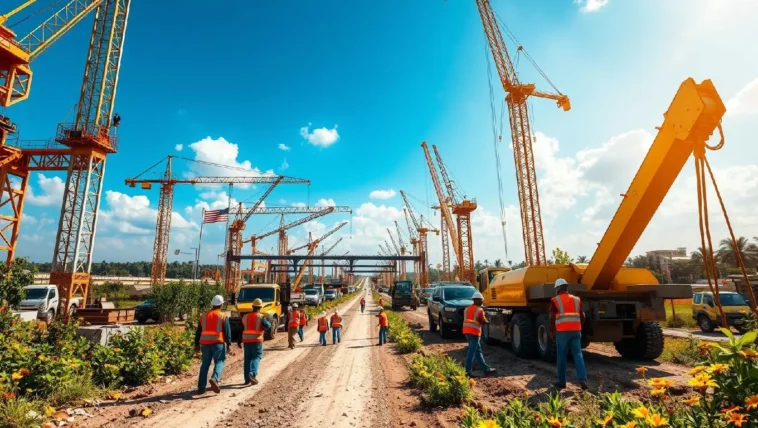Southeast Infrastructure Development
Massive Southeast Infrastructure Boost: New Projects Unveiled!
Southeast Infrastructure Development is poised to transform communities and boost the regional economy.Southeast Nigeria’s Ambitious Leap: Unveiling a New Era of Infrastructure Development
For too long, the narrative surrounding Southeast Nigeria has been one of untapped potential, hindered by infrastructural deficits that have stifled economic growth and limited the quality of life for its citizens. But a new chapter is being written, one paved with asphalt, powered by electricity, and driven by a vision of a prosperous future. A wave of ambitious infrastructure projects is sweeping across the region, promising to reshape the landscape and unlock unprecedented opportunities.
From the bustling streets of Onitsha to the serene hills of Enugu, a transformation is underway. Roads are being rebuilt, bridges are being erected, and power plants are being commissioned, all with the goal of creating a more connected, efficient, and vibrant Southeast Nigeria. But what exactly are these projects, and what impact will they have on the lives of everyday Nigerians?
This isn’t just about laying concrete and stringing cables; it’s about building a foundation for a brighter tomorrow. It’s about creating jobs, attracting investment, and empowering communities to thrive. This is the story of Southeast Nigeria’s infrastructure revolution, and it’s a story that demands to be told.
Breaking Ground: Key Infrastructure Projects Transforming the Southeast
The scope of the infrastructure development underway in Southeast Nigeria is truly remarkable. This isn’t just a piecemeal approach; it’s a comprehensive, multi-faceted strategy designed to address the region’s most pressing needs. From transportation to energy, these projects are poised to revolutionize the way people live and work.
One of the most ambitious undertakings is the rehabilitation and expansion of the region’s road network. Decades of neglect have left many roads in a state of disrepair, hindering trade and commerce. But now, contractors are hard at work, resurfacing existing roads, constructing new highways, and building bridges to connect communities that were once isolated.
But the transformation doesn’t stop there. Plans are also underway to upgrade the region’s power grid, ensuring a reliable and affordable supply of electricity to homes and businesses. New power plants are being built, and existing ones are being modernized, all with the goal of ending the chronic power outages that have plagued the Southeast for years.
Here’s a glimpse at some of the key projects that are currently underway:
- The Second Niger Bridge: A landmark project that will significantly improve connectivity between the Southeast and other parts of Nigeria.
- The rehabilitation of the Enugu-Onitsha Expressway: A vital artery for trade and commerce that is being completely overhauled.
- The construction of new power plants in Abia and Imo States: These projects will boost the region’s electricity generating capacity and reduce reliance on the national grid.
From Blueprint to Reality: Gauging the Progress of Ambitious Projects
While the vision for Southeast Nigeria’s infrastructure development is inspiring, the real test lies in its execution. Turning ambitious plans into tangible realities requires careful planning, effective management, and unwavering commitment. So, how far along are these projects, and what challenges lie ahead?
Progress has been made on several fronts. The Second Niger Bridge, a project that has been on the drawing board for decades, is nearing completion, promising to ease traffic congestion and boost trade. The rehabilitation of the Enugu-Onitsha Expressway is also well underway, with significant portions of the road already resurfaced.
However, challenges remain. Funding constraints, land acquisition issues, and security concerns have all posed obstacles to progress. But despite these hurdles, the commitment to transforming Southeast Nigeria’s infrastructure remains strong.
Here’s a quick snapshot of the progress on some key projects:
| Project | Status | Expected Completion Date |
|---|---|---|
| Second Niger Bridge | 95% Complete | 2024 |
| Enugu-Onitsha Expressway Rehabilitation | 70% Complete | 2025 |
| Abia State Power Plant | Under Construction | 2026 |
Following the Money: Unraveling the Funding Sources Behind the Infrastructure Boom
Building a modern infrastructure network requires significant financial resources. From the cost of materials to the salaries of workers, the expenses can quickly add up. So, where is the money coming from to fund Southeast Nigeria’s infrastructure revolution?
The answer is a mix of public and private investment. The federal government has allocated significant funds to infrastructure projects in the region, recognizing their importance to national development. State governments have also stepped up, contributing their own resources to support these initiatives.
But public funds alone are not enough. To bridge the funding gap, the government is actively seeking private investment, offering incentives to companies willing to invest in Southeast Nigeria’s infrastructure. These incentives include tax breaks, land concessions, and guarantees of return on investment.
International partners are also playing a role, providing loans and grants to support infrastructure development. The World Bank, the African Development Bank, and other international organizations have all pledged their support to Southeast Nigeria’s transformation.
Voices from the Ground: How New Infrastructure is Reshaping Daily Life in the Southeast
Ultimately, the success of Southeast Nigeria’s infrastructure revolution will be measured by its impact on the lives of ordinary people. Does it make it easier to get to work? Does it improve access to healthcare and education? Does it create new opportunities for economic advancement?
The early signs are encouraging. Improved roads are reducing travel times and making it easier for farmers to transport their goods to market. Reliable electricity is powering businesses and allowing students to study at night. New bridges are connecting communities that were once separated by rivers and ravines.
But the benefits go beyond the purely practical. Improved infrastructure is also fostering a sense of pride and optimism in the region. People are starting to believe that a brighter future is within reach, and that Southeast Nigeria can once again become a hub of economic activity and cultural innovation.
Here’s what some residents are saying about the impact of the new infrastructure:
“Before, it would take me hours to get to the market to sell my crops. Now, I can get there in half the time, and I can sell more goods.” – Farmer in Anambra State
“We used to have power outages every day. Now, we have electricity almost all the time, and my children can study without any problems.” – Teacher in Enugu State
Navigating the Bumps: Tackling the Challenges Blocking Infrastructure Progress
The path to infrastructure development is rarely smooth. Southeast Nigeria faces its fair share of challenges, from funding constraints to environmental concerns. Overcoming these obstacles requires creativity, resilience, and a commitment to finding sustainable solutions.
One of the biggest challenges is securing adequate funding. Infrastructure projects are expensive, and the government’s resources are limited. To overcome this hurdle, innovative financing mechanisms are needed, such as public-private partnerships and infrastructure bonds.
Environmental concerns also need to be addressed. Construction projects can have a significant impact on the environment, and it’s important to minimize these impacts through careful planning and mitigation measures. This includes conducting environmental impact assessments, implementing erosion control measures, and protecting sensitive ecosystems.
Security is another major concern. The Southeast has experienced a rise in crime and violence in recent years, which can disrupt construction projects and deter investment. To address this issue, the government needs to strengthen law enforcement and work with local communities to promote peace and stability.
Beyond Construction: How Infrastructure Investments are Revitalizing the Southeast Economy
The impact of infrastructure development extends far beyond the construction site. Improved roads, reliable electricity, and modern ports can transform the economic landscape of a region, attracting investment, creating jobs, and boosting trade.
Southeast Nigeria is already starting to see these benefits. The construction boom has created thousands of jobs, providing employment opportunities for local residents. Improved infrastructure is making it easier for businesses to operate and expand, attracting new investment to the region.
The region is also becoming a more attractive destination for tourists. Improved roads and airports are making it easier for visitors to reach the Southeast, and the region’s rich cultural heritage and natural beauty are drawing tourists from around the world.
Here’s how infrastructure development is impacting key sectors of the Southeast economy:
- Agriculture: Improved roads are reducing transportation costs and making it easier for farmers to get their goods to market.
- Manufacturing: Reliable electricity is powering factories and allowing businesses to operate more efficiently.
- Tourism: Improved infrastructure is making it easier for tourists to reach the Southeast and explore its attractions.
Powering the Future: The Critical Role of Energy Infrastructure in the Southeast
In the 21st century, access to reliable and affordable energy is essential for economic growth and social development. Southeast Nigeria has long struggled with chronic power shortages, which have hampered industrial growth and limited the quality of life for its citizens. But that is beginning to change, thanks to a concerted effort to upgrade the region’s energy infrastructure.
New power plants are being built, and existing ones are being modernized, all with the goal of increasing the region’s electricity generating capacity. Transmission lines are being upgraded to reduce power losses and ensure a more reliable supply of electricity to homes and businesses.
The government is also promoting the development of renewable energy sources, such as solar and wind power. These sources can provide a clean and sustainable source of energy, reducing reliance on fossil fuels and mitigating the effects of climate change.
Here are some of the key energy infrastructure projects that are currently underway in the Southeast:
- The construction of a new gas-fired power plant in Abia State.
- The modernization of the existing power plant in Afam, Rivers State.
- The development of solar power projects in several states across the region.
Building a Green Southeast: Integrating Sustainability into Infrastructure Plans
As Southeast Nigeria embarks on its infrastructure revolution, it’s important to ensure that development is sustainable and environmentally responsible. This means integrating environmental considerations into every stage of the planning and construction process, from selecting project sites to implementing erosion control measures.
The government is committed to promoting sustainable development practices, and is working with local communities and environmental organizations to ensure that infrastructure projects are environmentally sound. This includes conducting environmental impact assessments, minimizing deforestation, and protecting water resources.
The region is also exploring opportunities to develop green infrastructure, such as parks, green roofs, and permeable pavements. These features can help to reduce stormwater runoff, improve air quality, and enhance the quality of life for residents.
Looking Ahead: Charting a Course for Long-Term Infrastructure Success in the Southeast
The infrastructure revolution in Southeast Nigeria is just beginning. While significant progress has been made, much work remains to be done. To ensure long-term success, it’s important to have a clear vision, a well-defined strategy, and a commitment to continuous improvement.
The government needs to continue to invest in infrastructure, prioritizing projects that have the greatest economic and social impact. It also needs to create a favorable investment climate, attracting private capital and encouraging innovation.
Local communities need to be involved in the planning and decision-making process, ensuring that their needs and concerns are taken into account. And everyone needs to work together to promote transparency and accountability, ensuring that infrastructure projects are implemented efficiently and effectively.
With a clear vision, a strong commitment, and a collaborative approach, Southeast Nigeria can build a world-class infrastructure network that supports economic growth, improves the quality of life for its citizens, and positions the region for a brighter future. The time to act is now, and the opportunity is there for the taking. Let the construction continue, and let the transformation begin!
As Southeast Nigeria undergoes its transformative infrastructure boom, the demand for reliable and efficient construction equipment has never been higher. From the heavy machinery needed for road construction to the precision tools required for electrical installations, the success of these projects hinges on having the right equipment at the right time.
Whether you’re a seasoned contractor working on a major highway project or a small business owner looking to upgrade your equipment fleet, finding the right tools can be a daunting task. With so many options available, it’s important to choose equipment that is not only reliable and durable but also cost-effective and suited to the specific needs of your project.
Interested in exploring the latest construction equipment that can help you maximize efficiency and minimize downtime? We’ve compiled a list of top-rated products that are essential for any infrastructure project. Check out our selection below, and let us know your thoughts in the comments! Don’t forget to subscribe to our newsletter for more updates and exclusive deals on construction equipment and other essential resources.
Shop Products On Amazon
Shop Products on Ebay









Trending Similar Stories in the News
AIIB, NEDA Partner to Advance Sustainable Connectivity in Southeast Asia Asian Infrastructure Investment Bank...
XCMG Certified Pre-Owned Crawler Cranes Deployed in Southeast Asia to Support Large-Scale Infrastructure Projects ANTARA English...
Trending Videos of Southeast Infrastructure Development
A Review Of Nigeria’s Infrastructure Development In 2021
Similar Popular Articles
#NigeriaInfrastructure #SoutheastDevelopment #EconomicGrowth #CommunityDevelopment #InfrastructureProjects
Southeast, Infrastructure, Development, Nigeria, Projects






Massive Southeast Infrastructure Boost: New Projects Unveiled!
💬 What’s your take? Drop a comment below! ⬇️
#BreakingNews #LatestUpdate #StayInformed
📖 Read More: https://tinyurl.com/25u9teua